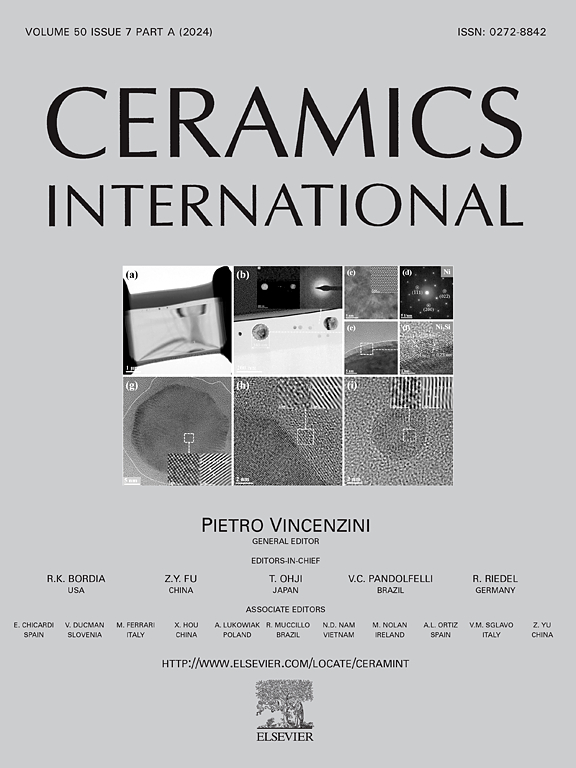Design of all-inorganic Sr5(PO4)3Cl: Eu2+ phosphor-in-glass for next generation violet-chips-excited sunlight-like healthy lighting
IF 5.1
2区 材料科学
Q1 MATERIALS SCIENCE, CERAMICS
引用次数: 0
Abstract
To call for green and low-carbon lighting development strategy, sunlight-like health lighting has become the next generation of light-emitting diode (LED) trends. The conventional LEDs are deficient in the violet part and contain high-radiation blue light which is harmful to human eyes. The traditional organic phosphor and chip packaging mode leads to poor heat dissipation. Therefore, it cannot meet the human demand for high-quality, healthy lighting. In this study, a series of violet-excitable blue Sr5(PO4)3Cl: Eu2+ (SPOC) phosphor-in-glass (PiG) films were prepared. The PiG film can not only compensate for the violet-yellow gap in the spectral component but also have excellent luminescence performance and reliability. Significantly, the lower co-sintering temperature (335 °C) allows it to maintain 89 % of the initial phosphor quantum efficiency. Relative to the initial state, PiG (Ea = 0.143 eV) at the optimal sintering temperature maintains a 34 % higher resistance to thermal quenching than phosphor-in-silicon (PiS) at 175 °C. This blue PiG-prepared color converter was remotely packaged with a violet chip to achieve a sunlight-like LED with a color rendering index of 96.3 and 100 % color saturation. This research offers great potential for the development of next-generation sunlight-like health lighting.
新一代紫外光芯片激发类阳光健康照明的全无机Sr5(PO4)3Cl: Eu2+玻璃磷设计
为呼唤绿色低碳照明发展战略,类阳光健康照明已成为下一代发光二极管(LED)的发展趋势。传统的led缺乏紫色部分,含有对人眼有害的高辐射蓝光。传统的有机荧光粉和芯片封装模式导致散热不良。因此,它不能满足人类对高品质、健康照明的需求。本研究制备了一系列可紫外光激发蓝色Sr5(PO4)3Cl: Eu2+ (SPOC)玻璃中磷(PiG)薄膜。该薄膜不仅可以弥补光谱成分中的紫黄色间隙,而且具有优异的发光性能和可靠性。值得注意的是,较低的共烧结温度(335°C)使其能够保持初始荧光粉量子效率的89%。相对于初始状态,最佳烧结温度下的PiG (Ea = 0.143 eV)比175℃下的硅中磷(PiS)的耐热猝灭性高34%。该蓝色pig制备的颜色转换器与紫色芯片远程封装,实现了显色指数为96.3和100%色彩饱和度的类似阳光的LED。这项研究为下一代类似阳光的健康照明的发展提供了巨大的潜力。
本文章由计算机程序翻译,如有差异,请以英文原文为准。
求助全文
约1分钟内获得全文
求助全文
来源期刊

Ceramics International
工程技术-材料科学:硅酸盐
CiteScore
9.40
自引率
15.40%
发文量
4558
审稿时长
25 days
期刊介绍:
Ceramics International covers the science of advanced ceramic materials. The journal encourages contributions that demonstrate how an understanding of the basic chemical and physical phenomena may direct materials design and stimulate ideas for new or improved processing techniques, in order to obtain materials with desired structural features and properties.
Ceramics International covers oxide and non-oxide ceramics, functional glasses, glass ceramics, amorphous inorganic non-metallic materials (and their combinations with metal and organic materials), in the form of particulates, dense or porous bodies, thin/thick films and laminated, graded and composite structures. Process related topics such as ceramic-ceramic joints or joining ceramics with dissimilar materials, as well as surface finishing and conditioning are also covered. Besides traditional processing techniques, manufacturing routes of interest include innovative procedures benefiting from externally applied stresses, electromagnetic fields and energetic beams, as well as top-down and self-assembly nanotechnology approaches. In addition, the journal welcomes submissions on bio-inspired and bio-enabled materials designs, experimentally validated multi scale modelling and simulation for materials design, and the use of the most advanced chemical and physical characterization techniques of structure, properties and behaviour.
Technologically relevant low-dimensional systems are a particular focus of Ceramics International. These include 0, 1 and 2-D nanomaterials (also covering CNTs, graphene and related materials, and diamond-like carbons), their nanocomposites, as well as nano-hybrids and hierarchical multifunctional nanostructures that might integrate molecular, biological and electronic components.
 求助内容:
求助内容: 应助结果提醒方式:
应助结果提醒方式:


